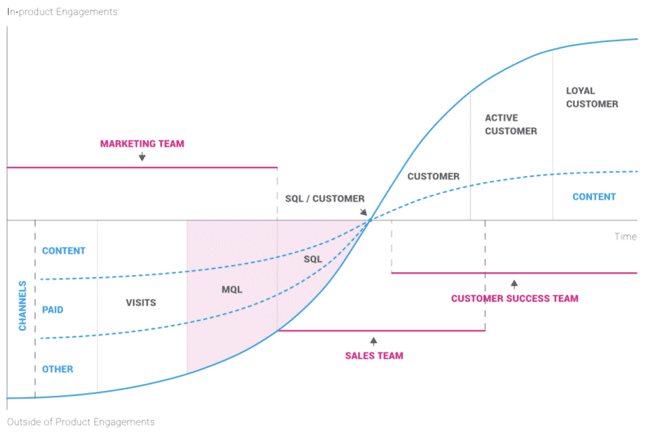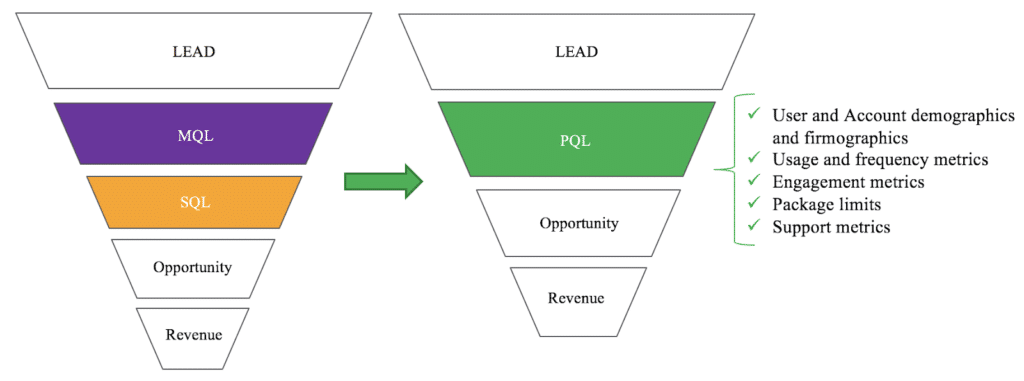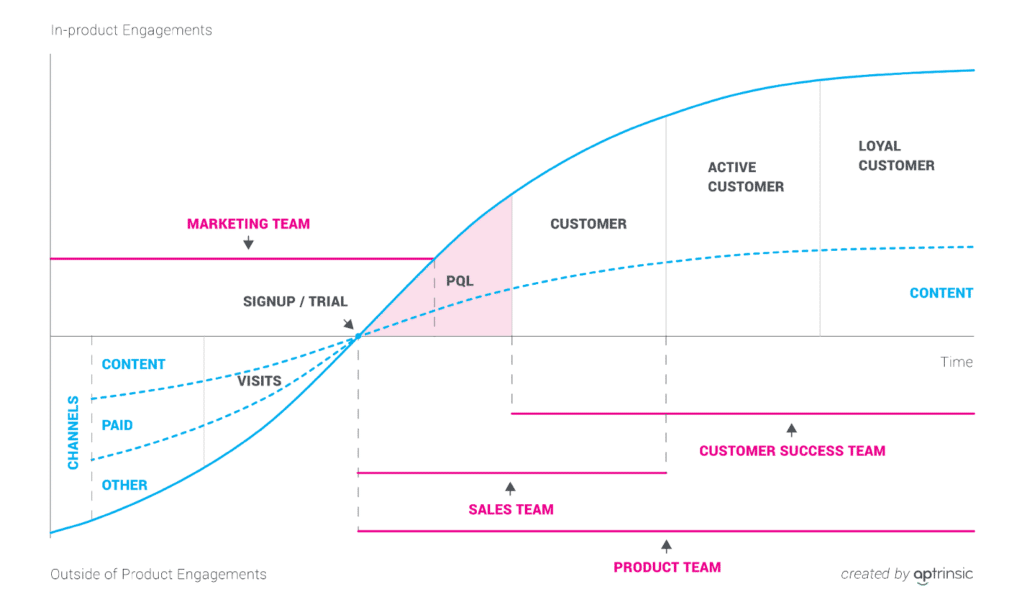In my previous post Why Product Qualified Leads Are Rapidly Being Adopted In SaaS I wrote about the main drivers that led many SaaS companies to adopt a new and more effective approach to qualify prospects. That new approach hinges on leading with the product and using feature and usage as primary lead qualification metrics.
PQL vs MQL
I’ll open with an interesting fact published by SiriusDecisions with regards to marketing qualified leads (MQLs):
98% of marketing qualified leads never result in closed business.
Assuming marketing is judicious about which leads it sends to sales for follow-up, clearly MQLs are not the best way to model leads.

In the traditional MQL model, marketing teams focus on nurturing prospects from awareness to qualified leads. The goal is for marketing to fill up the sales pipeline, and for sales to qualify these leads and convert them to opportunities. Once a deal is closed, sales passes the baton to customer success.
They use marketing automation to nurture prospects over time until they become “qualified” by a lead scoring mechanism. Usually by relentlessly emailing users or getting them to complete a form for gated content or sequence of gated assets.
But how qualified is someone just because they filled out a form or opened a few emails? Most lead scoring models give too much weight to this activity. Marketing sometimes “games the system” to achieve its MQL goals. Send enough nurture emails or run enough webinars and you’ll MQL everyone.
Many of us have been in intense meetings where sales doesn’t make their numbers, and the blame ultimately is assigned to marketing for low-quality leads.
The Customer Journey
The customer journey spans department silos: marketing, sales, customer success and — in some companies — the product team. This fragmentation makes the process more complicated than necessary, making it difficult to satisfy buyer expectations for a seamless experience. The organization tends to lose track of the buyer’s pain points and specific needs, requiring the buyer to continually explain these when interacting with different people in the company.
A fitting analogy is the telephone game where you whisper a story to a group of people one person at a time to see how much it changes by the end. A similar phenomenon often happens in an MQL-driven pipeline: the leads and opportunities you create often look very different from the target persona you built your product for. The gist of it is that “sales and marketing” alignment around MQLs can result in focus on the wrong goals.
The Emerging PQL Model
Product qualified leads (PQLs) are qualified leads that demonstrated buying intent based on product interest, usage, and behavioral data.
PQLs provide a more accurate method of tracking customer journeys from signup to cross-sell/upsell. This is a key metric for any company that’s transitioning to a product led growth strategy.

PQL is a cross-functional framework and the models will vary from product to product and from B2C and B2B. Here are a few basic metrics gathered from product leaders:
- User and account profiles. Demographics and firmographics such as company size, industry and revenue helps sales focus on the most relevant accounts.
- Behavioral. This is about measuring and discovering key converting behaviors, including feature usage and frequency of use. An example is users that were able to complete their onboarding process or use a golden feature.
- Customer engagements. Tracking product and marketing engagements, whether it’s lead source, in-app messaging, or response to content or emails, can indicate the customer stage or how far they are on their journey.
- Package limits. Number of seats or usage thresholds can be an immediate qualification signal and generate an upsell opportunity.
- Health score. Support tickets and customer feedback can provide additional perspective for the overall qualification score.

The 5 pillars to Accelerate Growth Using Product Qualified Leads
The following 5 pillars are a helpful framework for organizations wanting to accelerate growth using PQLs.
1. Become product led
Make sure marketing, sales and product teams are aligned behind the product and the core personas the product serves. You also want product leadership to make growth a high priority in product initiatives. That means assigning development resources to focus on designing features with the goal of increasing customer acquisition and retention. It also means the product team should be involved in finding ways to nurture users as they use the product.
Delivering great product experiences with every release is fundamental to driving adoption and capitalizing on your engineering investments. Using in-app engagements to onboard relevant users based on real-time behavior and the account profile is key to introducing new features in a contextual and relevant way. Product qualified leads will be influenced by effective onboarding for signup or upselling into a new feature.
2. Drive prospects to sign up
Once prospects reach a certain qualification threshold level, drive them to sign up. Or, if your product can solve an immediate need (such as Dropbox for document storage and sharing), encourage immediate sign ups.
Delivering the product experience via a demo or trial is the optimal way for prospects to realize what your product solves and how can they benefit from it. However, if you’re not providing free trials or demos, offer short videos that illustrate the value of your product. Your product is your best sales tool!
3. Establish a product-oriented sales team
Pricing model is a topic unto itself, and the right model depends on the company’s stage and target market. Due to the consumerization of B2B SaaS, we’re seeing pricing models that are a combination of free-tier to incremental upsells associated with usage and value.
Arm your sales team with the right pricing and packaging levers. Your customers should clearly see the value behind your pricing model and why they should upgrade. Set the right metrics behind features related to package limits or extended capability features as part of your PQL model.
Train your sales teams to understand the core use cases your product addresses. Your sales reps must become trusted advisors. To do that, they must truly understand buyers’ pain points and engage in use case-oriented discussions.
4. Continuously measure and onboard users
Measuring adoption and PQLs will help you learn about your customers.
Focus on the areas of the funnel that help you best address and prioritize based on what’s most impactful for your business: accelerating growth or driving retention and cross-sell. Make sure your first mile of product is optimized by measuring new signups using retention cohorts to learn converting behaviors and features. Don’t ignore marginal users as you grow your install base; the early majority will focus more on basic core features and ease of use than the early adopters.
Even if prospects see the potential and purpose of your offering, they want to know how your product will immediately benefit them when they their first use it. They want both the simple and powerful from a features perspectives, and it’s your job to find the right balance between adding more features or improving the usability and productivity of core features.
5. Democratize data
Giving your product, sales and marketing teams easy access to PQLs and product usage data is key for a successful PQL model. Data access helps expedite decision-making and uncover opportunities across teams. Data-driven discussions are much more productive than ones grounded in opinion.

